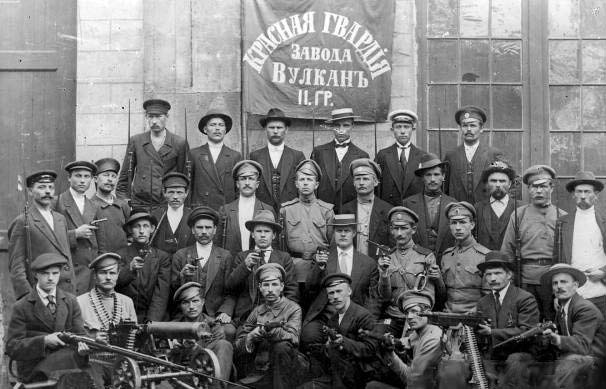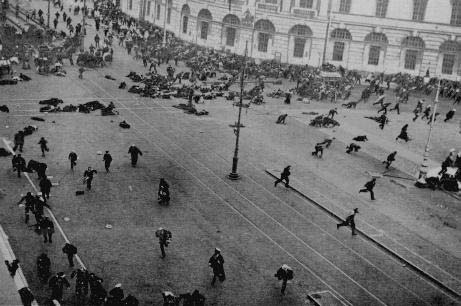 The time was ripe for war. Russia was struggling economically and was on the brink of financial collapse. The sharp increase in prices, as well as rabid unemployment, only fueled the already dissatisfied working class’ zeal for political change.
The time was ripe for war. Russia was struggling economically and was on the brink of financial collapse. The sharp increase in prices, as well as rabid unemployment, only fueled the already dissatisfied working class’ zeal for political change.
The ideology of Karl Marx, who theoretically championed the cause of the working class, was being hailed as the answer for a new Russia. Red October was on the horizon.
Setting The Stage
Russia’s Provisional Government’s control was short-lived, beginning in March of 1917 and ending in October of that same year. Led by Alexander Kerensky, the Provisional Government was short-sighted and ill-advised. It was the cause of a brewing kettle of discontent among the working class, who viewed the Provisional Government’s favor to the Middle Class as an insult.
 Fueled by the promises of a better life by Vladimir Lenin, who was a follower of Karl Marx, the working class (largely comprised of peasants) made the resounding decision to revolt. This working class, also known as Bolsheviks, began the offensive by staging revolutions beginning in July of 1917. Kerensky made several feeble attempts to keep a grip on his government, including ordering the Bolsheviks to be executed for insurrection.
Fueled by the promises of a better life by Vladimir Lenin, who was a follower of Karl Marx, the working class (largely comprised of peasants) made the resounding decision to revolt. This working class, also known as Bolsheviks, began the offensive by staging revolutions beginning in July of 1917. Kerensky made several feeble attempts to keep a grip on his government, including ordering the Bolsheviks to be executed for insurrection.
Russia was also embroiled in World War I during this time, which only added to the unrest. The Bolsheviks, who comprised the majority of soldiers in combat, felt that the nobility of the country had exploited the poor for their own benefit. Soldiers already on the warfront, when learning of the Bolsheviks’ plight under Kerensky, abandoned their posts and fled home to support their friends and families, using their war weapons to overpower the nobility and seize their property.
The Conflict Accelerates
 The Provisional Government made several attempts to stop the progression of the uprising, with no success. In July, Kerensky issued an edict calling for the arrest and execution of prominent figures in the uprising, including Lenin, forcing Lenin to go underground to oversee the revolution.
The Provisional Government made several attempts to stop the progression of the uprising, with no success. In July, Kerensky issued an edict calling for the arrest and execution of prominent figures in the uprising, including Lenin, forcing Lenin to go underground to oversee the revolution.
Internal struggles within the Provisional Government only served to exacerbate its fall. Kerensky made a fated change in the Supreme Commander of the Provisional Army by replacing General Alexi Brusilov with General Lavr Kornilov. In a move that some attribute to Kornilov being intoxicated with his new position, he demanded the restoration of the death penalty against soldiers and also wished to make the factories militarized. Kerensky was unwilling to institute these changes, which led to conflict resulting in the demotion of Kornilov.
Enraged, Kornilov dispatched troops to overthrow Petrograd. Kerensky, realizing his personal danger, turned to the Bolsheviks for assistance. The Bolsheviks agreed to assist in the effort, although Lenin stated in a subsequent speech that their mission was in opposition to Kornilov rather than in support of Kerensky.
The Bolsheviks assembled a formidable army in a matter of days. Working in an organized fashion, they prepared for conflict by fortifying the city. Groups of the Bolsheviks went out to meet with Kornilov’s soldiers and discuss the situation. Within a relatively short period of time, the soldiers decided not to advance on Petrograd. The general of these soldiers took his own life, and Kornilov was arrested.
On September 25th, Kerensky formed a new left-wing support group in a last ditch effort to salvage his leadership. The group consisted of Mensheviks and Socialist Revolutionaries. With the Bolsheviks leading the Soviets, however, they had access to more than 25,000 troops, even though Lenin was still in hiding.
The Historic Revolution
The Bolsheviks, needing a headquarters from which to operate, set up a command center in a former school/convent known as the Smolny Institute. As their movement continued to organize, industrialists and the nobility placed pressure on Kerensky to put a stop to the movement. In a reactive measure, Kerensky shut down the Bolshevik newspaper and ordered that the telephone lines to the Smolny Institute be cut. Leon Trotsky, a Soviet contemporary of Lenin, persuaded Lenin that the time had come for action, and Lenin agreed. On October 24, 1917, the Bolsheviks were ordered to man the State Bank, the telephone station and the railway stations.
On October 25th, the Bolshevik offensive, also known as the Red Guard, completely surrounded the Winter Palace, within the walls of which were the cabinet members of the existing government, minus Kerensky who had fled the premises.
The Cossacks, who defended the Palace on behalf of the cabinet members, exchanged gunshots briefly with the Bolsheviks before surrendering. The victorious Red Guards entered the Winter Palace and arrested the cabinet members.
The next day, on October 26, 1927, the Russian Congress met and relinquished power to the “Soviet Council of People’s Commisars” with Vladimir Lenin being named as Chairman and a new cabinet appointed.
The After Effects
Upon the completion of the transition of power, Lenin set about the task of getting Russia untangled from its connection to World War I. Lenin issued a warning to the other countries involved in the war, threatening to have the Red Arm take action if his message was unheeded. Unfortunately for Lenin, the message was ignored and alternative means were sought by Lenin. There were rumors that Germany would invade Petrograd and Lenin was desperate to prevent this from happening.
Lenin pulled the Russian troops out World War I, which was costly, and sought a peace agreement with Germany and Austria, an effort which met with success. As a concession, though, Lenin relinquished lands that had been under Russian control since the time of Peter the Great, including Poland, Ukraine, Belarus, and some coal mining lands in southern Russia. Russia would not regain these lands until after the end of World War II.
Summing It Up
Again, with the October Revolution of 1917, we see an emphasis of an old adage that says “power corrupts, and absolute power corrupts absolutely.” With the revolutionary changes that men envisioned came problems and abuses that these well-meaning men did not anticipate or prepare for.
In its zeal to protect the citizenry, the Bolsheviks established the setting for a communist state that would eventually also assume complete control of all aspects of the USSR. The equality they sought was achieved, but they were not prepared for the resultant widespread poverty that would ensue, nor the complete codependence upon government that would ensue from communism.
The efforts of the October Revolution were shattered in 1991, when the Soviet Union (or USSR) collapsed and the country once again became “Russia.”